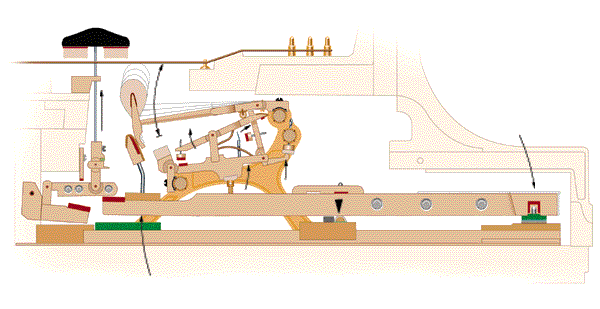 On
the left you can see a diagram of the action of one single note.
On
the left you can see a diagram of the action of one single note. Piano Background
To fully understand the methods of analysis and the benefits of our project, it is important to understand the basics of piano technology and maintenance. Proper maintenance of a piano involves three procedures.
"Tuning" involves adjusting, very slightly, the tension of each string of the piano in order to get the precise pitch of the musical scale. The tension is adjust by turning pegs at the top of the piano with a special tuning lever.
The second procedure is called "regulation." Sound is produced in the piano by means of a felt-covered hammer striking a tight steel wire. The mechanical system that moves the hammer is very complex, and requires many precise adjustments to give the keys the right "weight" and the keyboard the correct overall responsiveness. Many regulation adjustments are performed by removing the "action" from the piano. The action is the collection of all 88 hammer mechanisms and the keyboard.
The third procedure, and the main concern of this project, is called "voicing."
Where tuning adjusts the precise pitch of the sound and regulation adjusts
the feel of the keyboard, voicing adjusts the "tone" of the piano.
Tone, or timbre, can be described as the quality of the note. The difference
in tone is what makes a saxophone sound different than a violin, or a piano.
The voicing process involves physically manipulating the felt covering each
hammer. The process begins with the technician striking each note of the piano
and marking those notes that seem a little "dull" or a little "bright."
Often these differences are quite hard to hear in an individual tone, and
it can take years of experience to aquire proficiency.
 On
the left you can see a diagram of the action of one single note.
On
the left you can see a diagram of the action of one single note.
On the right we have the action of the whole piano, with a technician
manipulating the hammers. 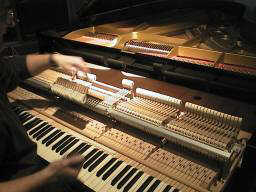
After a technician has evaluated each note, they must remove the action to easily reach the hammers. The actual manipulation of the hammers includes three main techniques: needling, filing, and chemical treatment of the hammers. By needling the hammer felt with a special tool, the technician "cuts" small strands of the tightly stretched felt to soften the hammer felt overall. By filing the hammer, the technician can subtly shape the hammer, changing the contact region of the hammer felt with the string. By chemical treatment of the hammer felt the technician can also harden a hammer.
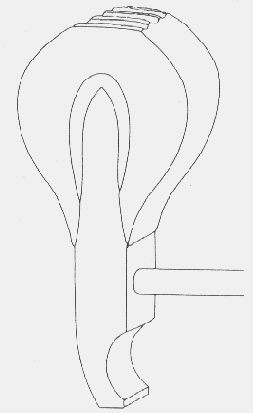
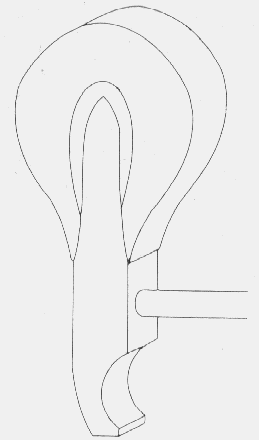 Illustrations of worn hammer and filed hammer.
Illustrations of worn hammer and filed hammer.
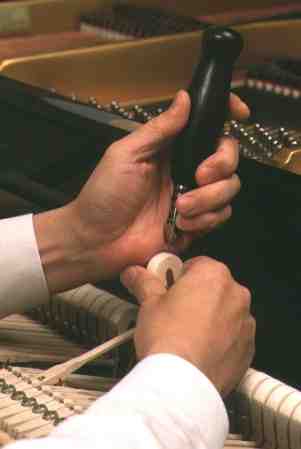 The needling process
The needling process
The precise nature of how each voicing procedure actually affects the sound, or in scientific terms the acoustic signal, is unknown. Even for a technician with decades of experience, the voicing process is still one, at best, of directed trial and error. The technician will play each note, remove the action, voice the hammers, and play the notes again. If they are not happy with the results, the whole process is repeated. Because of the complex nature of the procedure, voicing a concert grand for a concert can take hours of work.
Our project involves trying to facilitate this laborious ceremony by creating a program that could be used as a reference for the technician. It hopes to eliminate some of the mystery out of the voicing procedures, and thereby reduce the amount of trial and error in the voicing process. Our program needs to record notes from the piano and collect data on the power and the inharmonicities in the partials. It then needs to be able to store data, and compare new and old data, or eventually with an ideal voicing distribution. As of now, there exists no software that accomplishes all of these goals.